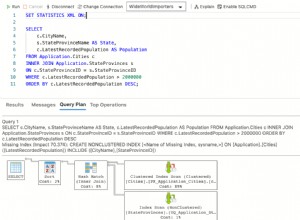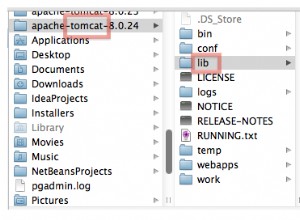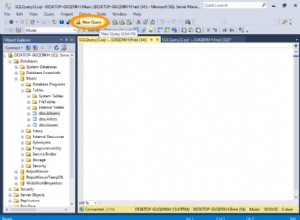Ok, quindi ho creato questa brutta cosa che permette di rimuovere le colonne dalle tabelle in fase di esecuzione.
1.Dovrai aggiungere l'overload del costruttore al tuo DbContext (*.edmx ->*.Context.tt ->*.Context.cs ) come:
public partial class EcomEntities : DbContext
{
public EcomEntities(DbConnection connection)
: base(connection, true)
{
}
public EcomEntities(string connectionString)
: base(connectionString)
{
}
2. Avrai bisogno di un cambio di connessione al database (sono qui esplicitamente i parametri di codificazione per chiarezza, normalmente li si ottiene da SystemToDatabaseMapping ). ColumnsToRemove ha nomi di tabelle e colonne che devono essere rimossi, EF connectionString è autonomo esplicativo
.
public void ChangeConnection(SystemToDatabaseMapping systemToDatabaseMapping)
{
if (systemToDatabaseMapping.ColumnsToRemove != null)
{
var entityConnection = EntityConnectionExtensions.Create(
new List<ColumnsToRemove> { new ColumnsToRemove("QUOTE_HOUSE", "UPRN"), new ColumnsToRemove("QUOTE_HOUSE", "INSIGHT_DATA") },
systemToDatabaseMapping.ConnectionString);
this.Ecom = new EcomEntities(entityConnection);
}
else
{
this.Ecom = new EcomEntities(systemToDatabaseMapping.ConnectionString);
}
....
}
E poi il tizio che in realtà fa cose brutte come rimuovere i nodi dagli xml di mappatura delle entità, prima di inviarli a MetadataWorkspace
using System.Collections.Generic;
using System.Data.Common;
using System.Data.Entity.Core.EntityClient;
using System.Data.Entity.Core.Mapping;
using System.Data.Entity.Core.Metadata.Edm;
using System.Linq;
using System.Reflection;
using System.Text.RegularExpressions;
using System.Xml;
using System.Xml.Linq;
public static class EntityConnectionExtensions
{
public static IEnumerable<XElement> ElementsAnyNS<T>(this IEnumerable<T> source, string localName)
where T : XContainer
{
return source.Elements().Where(e => e.Name.LocalName == localName);
}
public static IEnumerable<XElement> ElementsAnyNS(this XContainer source, string localName)
{
return source.Elements().Where(e => e.Name.LocalName == localName);
}
private static void RemoveNodes(XElement element, List<ColumnsToRemove> tableAndColumn)
{
if (element.Attribute("Name") != null && tableAndColumn.Any(oo => oo.Table == element.Attribute("Name").Value) ||
element.Attribute("StoreEntitySet") != null && tableAndColumn.Any(oo => oo.Table == element.Attribute("StoreEntitySet").Value))
{
var matchingSelectParts = tableAndColumn.Where(oo => element.Value.Contains(string.Format("\"{0}\".\"{1}\" AS \"{1}\"", oo.Table, oo.Column))).ToList();
if (matchingSelectParts.Any())
{
foreach (var matchingSelectPart in matchingSelectParts)
{
var definingQuery = element.ElementsAnyNS("DefiningQuery").Single();
definingQuery.Value = definingQuery.Value.Replace(string.Format(", \n\"{0}\".\"{1}\" AS \"{1}\"", matchingSelectPart.Table, matchingSelectPart.Column), "");
}
}
else
{
var nodes = element.Nodes()
.Where(o =>
o is XElement
&& ((XElement) o).Attribute("Name") != null
&& tableAndColumn.Any(oo => ((XElement) o).Attribute("Name").Value == oo.Column));
foreach (var node in nodes.ToList())
{
node.Remove();
}
}
}
}
public static EntityConnection Create(List<ColumnsToRemove> tablesAndColumns, string connString)
{
var modelNameRegex = new Regex(@".*metadata=res:\/\/\*\/([a-zA-Z.]*).csdl|.*");
var model = modelNameRegex.Matches(connString).Cast<Match>().SelectMany(o => o.Groups.Cast<Group>().Skip(1).Where(oo => oo.Value != "")).Select(o => o.Value).First();
var conceptualReader = XmlReader.Create(Assembly.GetExecutingAssembly().GetManifestResourceStream(model + ".csdl"));
var mappingReader = XmlReader.Create(Assembly.GetExecutingAssembly().GetManifestResourceStream(model + ".msl"));
var storageReader = XmlReader.Create(Assembly.GetExecutingAssembly().GetManifestResourceStream(model + ".ssdl"));
var conceptualXml = XElement.Load(conceptualReader);
var mappingXml = XElement.Load(mappingReader);
var storageXml = XElement.Load(storageReader);
foreach (var entitySet in new[] {storageXml, conceptualXml}.SelectMany(xml => xml.Elements()))
{
if (entitySet.Attribute("Name").Value == "ModelStoreContainer")
{
foreach (var entityContainerEntitySet in entitySet.Elements())
{
RemoveNodes(entityContainerEntitySet, tablesAndColumns);
}
}
RemoveNodes(entitySet, tablesAndColumns);
}
foreach (var entitySet in mappingXml.Elements().ElementAt(0).Elements())
{
if (entitySet.Name.LocalName == "EntitySetMapping")
{
foreach (var entityContainerEntitySet in entitySet.Elements().First().Elements())
{
RemoveNodes(entityContainerEntitySet, tablesAndColumns);
}
}
RemoveNodes(entitySet, tablesAndColumns);
}
var storageCollection = new StoreItemCollection(new [] {storageXml.CreateReader()});
var conceptualCollection = new EdmItemCollection(new[] { conceptualXml.CreateReader() });
var mappingCollection = new StorageMappingItemCollection(conceptualCollection, storageCollection, new[] {mappingXml.CreateReader()});
var workspace = new MetadataWorkspace();
workspace.RegisterItemCollection(conceptualCollection);
workspace.RegisterItemCollection(storageCollection);
workspace.RegisterItemCollection(mappingCollection);
var connectionData = new EntityConnectionStringBuilder(connString);
var connection = DbProviderFactories
.GetFactory(connectionData.Provider)
.CreateConnection();
connection.ConnectionString = connectionData.ProviderConnectionString;
return new EntityConnection(workspace, connection);
}
}
public class ColumnsToRemove
{
public ColumnsToRemove(string table, string column)
{
Table = table;
Column = column;
}
public string Table { get; set; }
public string Column { get; set; }
}
public class SystemToDatabaseMapping
{
public string ConnectionString { get; set; }
public List<ColumnsToRemove> ColumnsToRemove { get; set; }
}
Spero che questo ti faccia risparmiare un po' di tempo.




